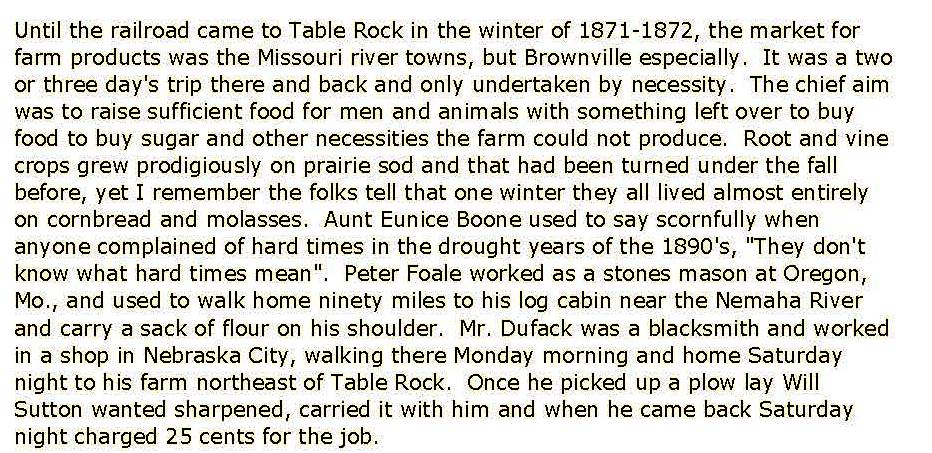LONG DISTANCES
1859, a traveler from brownville describes his journey to table rock and what he found there |
"A.S.B." reported on a Trip to Table Rock in a September 1859 edition of the Nebraska Advertiser of Brownville. Over the rivers and creeks, over two "divides" to Kirkham's Cove, squatters and settlers described in romantic terms. Then, after dark, with the road dim, by the lights of a distant village -- Table Rock
1933 ORAL HISTORY RECORD of elsie pepoon sutton about what happened to the original table rock and when |
In 1933, Elsie Pepoon Sutton interviewed each of the 9 people then still alive who had actually seen "the" Table Rock. She determined what it looked like and that it had fallen, not been knocked down. In the course of her interviews, she also gathered local history about other matters.
Corn probably headed to market at Denver but sold at Kearney as waited for wagon train to join. John R. Allen, born in 1846, was 87 in 1933. He came to Long Branch in 1865 but moved to the Howe farm in the Bunker Hill neighborhood in the fall of 1866. In 1866 they had a successful corn crop. After shelling it (by hand), they headed for market. "We got to Kearney and they wouldn't let us go on until there was a wagon train. We stayed a few days and Bill sold the corn."
Working on the railroad. In about 1860, he "went to railroading. Down on the Missouri River on the road from St. Joe to Council Bluffs. Then on one from Brunswick to Chillicothe. Then on the B. and M. road from Pacific Junction east." (He was presumably a gandy dancer -- the workers who built and maintained the rails.)
Corn probably headed to market at Denver but sold at Kearney as waited for wagon train to join. John R. Allen, born in 1846, was 87 in 1933. He came to Long Branch in 1865 but moved to the Howe farm in the Bunker Hill neighborhood in the fall of 1866. In 1866 they had a successful corn crop. After shelling it (by hand), they headed for market. "We got to Kearney and they wouldn't let us go on until there was a wagon train. We stayed a few days and Bill sold the corn."
Working on the railroad. In about 1860, he "went to railroading. Down on the Missouri River on the road from St. Joe to Council Bluffs. Then on one from Brunswick to Chillicothe. Then on the B. and M. road from Pacific Junction east." (He was presumably a gandy dancer -- the workers who built and maintained the rails.)
1939 memoir of elsie pepoon sutton -- getting to market
|
In her 1939 memoir about growing up in the Bunker Hill neighborhood ("North Table Rock"), Elsie Pepoon Sutton talked about the difficulty of the early settlers in getting to market before the railroad came.
|
Sutton also described the difficulty of finding work, and the great distances that some of the people traveled to find work:

